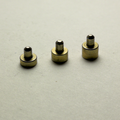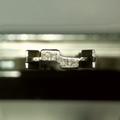IKON WSW: Difference between revisions
m (add individual side pin photo) |
m (added image of key) |
||
| Line 49: | Line 49: | ||
File:Ikon_WSW_finger_pin-Snow.jpg | Side pin | File:Ikon_WSW_finger_pin-Snow.jpg | Side pin | ||
File:IKON_WSW_pins-Reinder.png |Three sizes of key pins | File:IKON_WSW_pins-Reinder.png |Three sizes of key pins | ||
File:IKON_WSW_key_edge-Reinder.jpg |A key for a WSW cylinder. | |||
File:IKON WSW key blade-Reinder.png |A view of the bitting on a WSW key. | File:IKON WSW key blade-Reinder.png |A view of the bitting on a WSW key. | ||
File:IKON WSW key tip profile-Reinder.png |WSW key tip profile. | File:IKON WSW key tip profile-Reinder.png |WSW key tip profile. | ||
Revision as of 15:45, 14 January 2023
IKON WSW
| IKON WSW | |
 | |
| Name | IKON WSW |
|---|---|
| Manufacturer | IKON |
| Lock Type | Cylinder |
| Lock Design | Pin-tumbler, Sidebar |
| Specifications | |
| # of Components | 6 |
| Component Type | Pin-tumbler |
The WSW is a Pin-tumbler lock made by the German company IKON.
Principles of operation
The WSW key is bitted on the sides and edges of the blade and is reversible. The mark of inventor Bo Widen appears on the key bow. The key has a row of six dimple cuts matching six pin-tumblers at the top of the keyway. There are three different heights for these key pins. They are T-shaped and rest in matching chambers drilled in the core. The brass driver pins for this row of pins are a mix of three standard pins and three spool security pins.
The WSW also features one or two sidebars, depending on the model. The interior model has five side pins with a single sidebar. The exterior model adds either two or five additional side pins connected to a second sidebar. The steel side pins are spring-biased and control the sidebar(s) of the lock.
To open the lock, all six key pins and all side pins must be aligned at the shear line. (See also Pin-tumbler, Principles of operation)
Disassembly instructions
The WSW is disassembled in the same way as a traditional pin-tumbler cylinder, though extra attention must be paid to the sidebar and side pins during disassembly.
- Remove the c-clip holding the core in place
- Insert the key and turn the plug 30-45 degrees.
- Withdraw the plug from the cylinder, being careful to retain the sidebar and side pins.
- (A plug follower and core shims are strongly recommended)
Gallery
See also
| This article is a stub. You can help Lockwiki by expanding it. |














